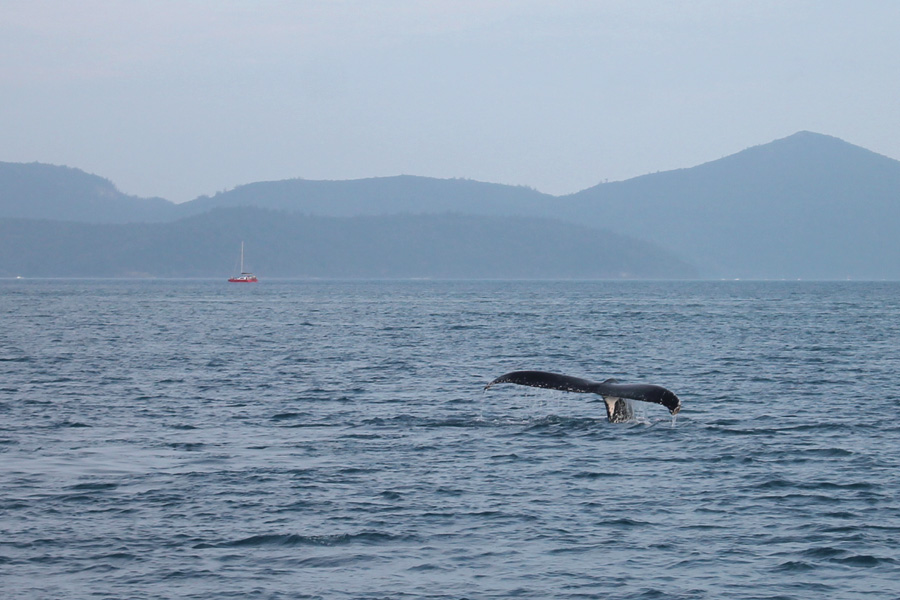Great Barrier Reef Marine Park Rules And Regulations Of Whale Watching
The Whitsundays are one of the best places in Australia for whale watching, but it's important to follow the rules and regulations set in place by the Great Barrier Reef Marine Park Authority. Because the Whitsunday Islands are part of the Great Barrier Reef Marine Park, the area is highly protected in order to maintain the precious biodiversity and ecosystems. Visitors to the Whitsundays are encouraged to enjoy the natural world and admire the marine life, but it's essential to be a responsible traveller.
Here is a quick rundown of the whale watching rules outlined by the Great Barrier Reef Marine Park Authority. Everyone in the Whitsundays must be conscious of protecting and preserving wildlife!

When can you see whales on the Great Barrier Reef?
You can see whales on the Great Barrier Reef from May to September each year. Every winter, the Great Barrier Reef Marine Park sees an influx of humpback and minke whales as they migrate north from Antarctica to breed and raise their young. The warm waters of the Whitsundays make the perfect breeding ground and playground for whales off the coast of Australia!
Each and every dolphin and whale that enters the Great Barrier Reef Marine Park is protected. Most whale encounters in the Whitsundays are purely by chance, as there aren't many official whale watching tours and whales could be anywhere in the waters throughout winter. But whether you're on a boat tour, private charter, or whale watching excursion, it's vital that humans keep their distance and obey the rules and regulations for whale watching.
These private charters are perfect for spotting whales in the Whitsundays!
Great Barrier Reef Marine Park Whale Watching Rules
Here is an overview of the Great Barrier Reef Marine Park Authority's whale watching rules. Anytime you see a whale in the Whitsundays, make sure you follow these regulations which are designed to keep the animals safe and unbothered.
Distances from whales
- Boats must stay at least 100 metres away from whales
- Boats must stay at least 150 metres away from dolphins
- Boats must stay at least 300 metres away from a whale calf
- Jet skis must stay 300 metres away from whales
- If there are already 3 vessels within 300 metres of a whale or dolphin, all other vessels must stay outside the 300m radius
Approaching whales
- If you find yourself within the caution zone, stop your vessel and turn off the engines. Or disengage the gears and move away at a very slow speed.
- If you are closer than 50 metres to a dolphin, the vessel must not change course or speed suddenly
- Approach a whale or dolphin only from the rear or by positioning the vessel ahead of the whale or dolphin, and always in a position that is more than 30 degrees away from the animal
- If a whale approaches your vessel, try to avoid the animal by slowing down and steering away or putting the engines in neutral and letting the animal pass.
Aircraft distances
- All aircraft (including drones) must not go below 1,000 feet or within a 300 metre radius of a whale or dolphin.
- Never approach a whale or dolphin head on with an aircraft.
- Helicopters must not operate below 1,650 feet or within a horizontal radius 500 metres of a whale or dolphin.
Safe behaviours around whales or dolphins
- If you accidentally strike a whale or dolphin you must report it.
- Don't prohibit the animals' movement or pathways and never get in between a mother and her calf.
- Do not harm, harass, chase or injure them in any way.
- Do not attempt to touch or feel whales or dolphins.
- You must not enter the water within 300m of a whale or 100m of a dolphin
Please visit the Great Barrier Reef Marine Park website for a complete list of rules and regulations. Or study the photo below for a summary of allowed distances between whales!













